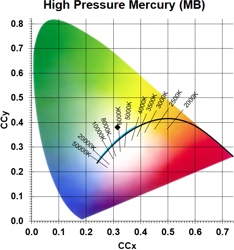
|
GEC MB/U High Pressure Mercury |

The principal reason for the continued use of MB lamps was that they worked better in the optical systems of many lanterns. The higher wattage types were made in clear tubular bulbs and the arc tube could be precisely located at the focal point of the reflector. Lower wattage types were offered in Pearl bulbs only, because the glare from such a small and intense arc tube was unacceptably high. Despite the diffuse glass, the central 'hot spot' of light emission was still quite small. With the fluorescent coated lamps, the entire bulb surface was the point of light emission and the large source area meant that the light was not so easy to control in optical systems. Light from a lantern would be thrown out at a much wider angle and although a greater area was illuminated, the intensity at any given point was considerably lower. Because this was unacceptable in many cases, the uncoated MB lamps continued to be offered.
While Mazda and Philips offered Pearl MB bulbs in the ellipsoidal bulb shape, GEC continued to make them to the original design in round bulbs. This ensured that the light centre length was maintained at the correct position.

| Manufacturer: | The General Electric Company PLC of England | |
| Lamp Power: | 125 Watts | |
| Lamp Current: | 1.15 Amps | |
| Lamp Voltage: | 125 Volts | For 220-250V Mains |
| Cap Type: | B22d-3/25x26 | Ni plated brass + vitrite |
| Bulb Finish: | Pearl | Soda-lime soft glass |
| Bulb Type: | PS-88 | PS-30 in eighths/inch |
| Overall Length: | 174 ± 4 mm | 6¾ inches |
| Light Centre Length: | 112 ± 4 mm | 4½ inches |
| Arc Length: | 25mm | 1 inch |
| Electrodes: | Backwound tungsten | Double carbonate emitter |
| Atmosphere: | Inner: Hg | Ar (8 atm) | Outer: Nitrogen |
| Luminous Flux: | 5,200 lm @ 100 hrs | 4,900 lm average |
| Luminous Efficacy: | 41.6 lm/W @ 100 hrs | 39.2 lm/W average |
| Colour Temperature & CRI: | CCT: 6000K | CRI: Ra 16 |
| Chromaticity Co-ordinates: | CCx: 0.315 | CCy: 0.380 |
| Burning Position: | Universal | Horiz. lumens 10% less |
| Rated Lifetime: | 7,500 hours | Rated to 70% survival |
| Warm-up & Re-strike Time: | 4 minutes | 5 minutes |
| Factory: | Shaw, Oldham | England |
| Date of Manufacture: | August 1978 | Date Code: KH |
| Original & Present Value: | £2 13s 0d (1968) | £30.79 (2005) |

